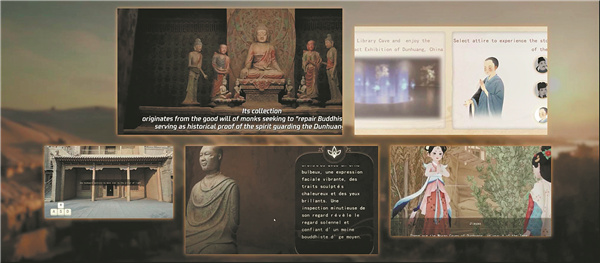Gaming technology enables worldwide culture sharing

Snapshots of the English version of the gamelike Digital Library Cave program, through which users can play the role of a time-traveling explorer of a millennium's twists and turns at the Mogao Caves in Dunhuang, Northwest China's Gansu province. [Photo provided to China Daily]
English and French versions of Dunhuang's Digital Library Cave give 'tourists' new experience, Fang Aiqing reports.
The potential of gaming technology facilitating cultural exchanges is increasing, exemplified in the English and French versions of a gamelike program, the Digital Library Cave, as it enables an expansive user base in taking a virtual tour of the Mogao Caves in Dunhuang, Northwest China's Gansu province.
Available on the Digital Dunhuang website since April 8, the global versions save foreign users the long and arduous journey to the grottoes, while enabling them to virtually witness and experience the rise and fall of the Library Cave that spanned more than a millennium.
The Library Cave, or Cave 17, is a wonder itself, not only because of the precious ancient documents found inside it. It also beholds the mystery of it remaining out of sight for almost 1,000 years and the twists and turns it went through after being accidentally discovered by Taoist priest Wang Yuanlu in 1900.
The once sand-buried treasure trove of more than 60,000 Buddhist manuscripts, government and socioeconomic documents, silk paintings, embroidery and sacred articles is among the most important archaeological discoveries of the 20th century.
By playing the role of a time-traveling explorer, users get to "participate" in a thousand years of history, from the time when the cave was built in the mid-9th century to when it was sealed and rediscovered. They also "experience" how the relics were lost or scattered, as a lot of them are now kept overseas.
A joint effort between Dunhuang Academy and technology company Tencent, the Digital Library Cave has reproduced, with a millimeter-level accuracy, the external cliff face of the Mogao Caves, its 16th and 17th caves, as well as the murals, statues and relics housed there.
It applies three-dimensional laser scanning, modeling and reconstruction technologies, as well as technological solutions and visual styles frequently used in digital games, such as physically based rendering and global dynamic lighting.
Users will interact with eight real historical figures appearing as non-player characters and can zoom in on 21 documents discovered in the Library Cave in a 3D exhibition hall.
According to Tencent, the week following the release of the Digital Library Cave in April last year saw 14 million users visit the game via the WeChat mini-program, Cloud Museum of Dunhuang Caves.
In September, the project won the "Star of Outstanding" title at the 2023 Global Awards for World Heritage Education Innovative Cases, given by the World Heritage Institute of Training and Research for the Asia and the Pacific Region under the auspices of UNESCO.
Xue Xiaoli, product designer of the Digital Library Cave, says the project's global editions aim to provide scholars of Dunhuang studies and aficionados of Dunhuang culture from around the world alternative digital access to the artifacts found in the Library Cave.
With a cover of a "game" targeting a wider audience, the program tells Dunhuang's history in a more direct, vivid and immersive way to audiences with different cultural backgrounds and age groups, Xue adds.





 Print
Print Mail
Mail
